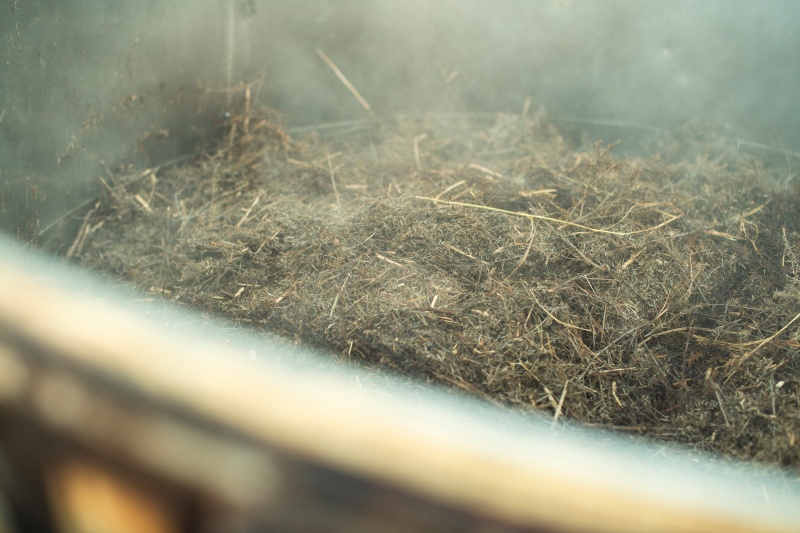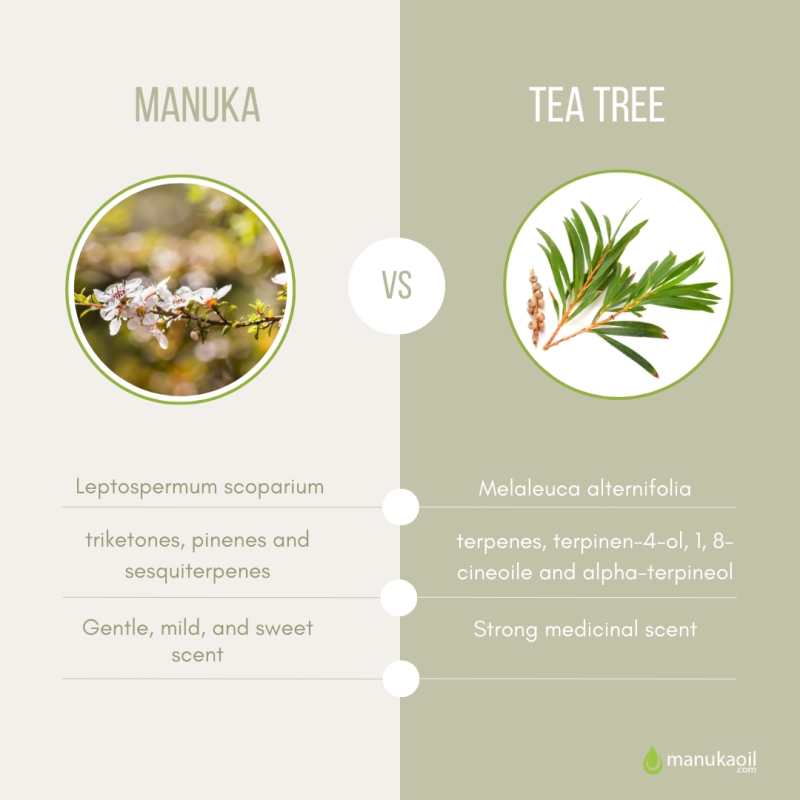Mānuka oil and tea tree oil are frequently mistaken for one another due to their similarities. They are, in fact, distinct from each other. Tea tree oil is a well-known household item for many individuals, whereas mānuka oil represents a relatively new industry concentrated in New Zealand.
Mānuka oil, derived from Leptospermum scoparium, is a relatively lesser-known essential oil. Some may argue it is one of the less frequently utilized oils in the realm of aromatherapy, despite its antimicrobial properties. This is especially evident when compared to the more widely recognized tea tree oil.
In this article, gain expert insights into the similarities and differences between mānuka oil and tea tree oil.
Mānuka Oil vs Tea Tree Oil
New Zealand’s unique geographical climate fosters the growth of exceptionally unusual plants, including the Tea Tree, which is one of the most ancient plant species. While it thrives primarily in low-lying, marshy terrain, its remarkable hardiness allows it to flourish in diverse environments. This includes high-altitude mountain slopes, enduring extreme conditions such as snow cover and harsh winds, which are often found near coastal areas. Presently, hybrid varieties of the Tea Tree can be encountered in numerous countries across the globe.
In the year 1770, following his landing in Botany Bay, Captain James Cook embarked on an exploration northward through the coastal regions of New South Wales. During this expedition, both he and his team of botanists encountered extensive groves of trees characterized by their adhesive, aromatic leaves. They observed the indigenous Aboriginal population brewing a concoction from the leaves of these trees and applying a salve made from paperbark to wounds.
It was in this context that the name “Tea” Tree was bestowed upon these trees.
In Australia and New Zealand, three distinct species belonging to the Myrtaceae family are commonly referred to as “Tea-tree:”
- New Zealand’s Mānuka (botanically known as Leptospermum scoparium)
- New Zealand’s Kānuka (botanically known as Kunzea ericoides)
- Australia’s Tea tree (botanically known as Melaleuca alternifolia)
While they share numerous similar properties, it is important to note that they are genetically distinct from one another.
The mānuka tree is indigenous to New Zealand and typically attains a more modest height, usually reaching approximately up to two metres in height. It is characterised by its somewhat spiky leaves and noticeably larger clusters of seeds, along with slightly larger flowers that can range in colour from white to a vibrant pink hue.
The kānuka tree is indigenous to Aotearoa New Zealand and possesses the capacity to reach impressive heights of up to 10 metres. It is distinguished by small creamy clusters of flowers and soft, rounded leaves.
The tea tree is endemic to Australia and has a diversity of nearly 300 different varieties, varying in height from two to five metres. These trees are characterised by their distinctive flowering pattern, with blooms clustering together to create a dense, bushy crown located at the tips of their branches.
The Extraction Process

Is the extraction process for mānuka oil and tea tree oil the same?
Yes. Both oils undergo steam distillation, a process that involves a multistage continuous distillation method in which steam serves as the stripping agent to extract oils. Steam is directed through the plant material, leading to the formation of a mixture of hot vapours. Subsequently, this mixture is collected and condensed, resulting in the formation of a liquid where the oil and water separate into two distinct layers.
Mānuka Oil and Tea Tree Oil

Mānuka oil is abundant in triketones and flavonoids, possessing potent antibacterial and antifungal properties akin to tea tree oil. These attributes are essential in addressing skin conditions, especially acne and related problems arising from bacterial proliferation.
While tea tree oil shares these properties, it is not as concentrated as mānuka oil. Tea tree oil contains a substantial amount of monoterpenes, which contribute to its strong odour, often regarded as unpleasant by many. In contrast, sesquiterpenes are prominent in mānuka oil, which are less volatile and yield a milder and more agreeable fragrance.
It is noteworthy that scientific research has demonstrated the significantly enhanced effectiveness of mānuka essential oil against gram-positive bacteria and fungi compared to tea tree oil. Specifically, mānuka oil has been found to be 20 to 30 times more potent against gram-positive bacteria and 5 to 10 times more potent against fungi.
| Properties | Mānuka Oil | Tea Tree Oil |
| Source | Various parts of the Leptospermum scoparium, a plant native to New Zealand’s Te Araroa region | Leaves of the Melaleuca alternifolia, a plant native to Australia’s New South Wales northeast coast |
| Main Chemical Components | triketones, pinenes and sesquiterpenes | terpenes, terpinen-4-ol, 1, 8-cineoile and alpha-terpineol |
| Odour | Milder and more pleasant fragrance | Strong, often regarded as unpleasant |
| Antibacterial Properties | Yes | Yes |
| Antifungal Properties | Yes | Yes |
| Antioxidant Properties | Yes | Yes |
| Antiseptic Properties | Yes | Yes |
| Antiviral Properties | Yes | Yes |
| Toxicity | No | Yes |
Further studies by the Cawthron Institute in Nelson and the Otago University Microbiology Department have conducted comprehensive testing of East Cape mānuka oil and tea tree oil against a diverse spectrum of human pathogens. Their findings reveal that East Cape mānuka oil exhibited the following advantages over tea tree oil:
- Mānuka oil proved to be 20 to 30 times more potent than Australian tea tree oil in combating gram-positive bacteria.
- It demonstrated greater efficacy against various strains of fungi.
- Additionally, it displayed effectiveness in countering gram-negative bacteria and viruses.
Mānuka Oil vs Tea Tree Oil: Aroma and Scent
Mānuka Oil has a gentle, sweet, and mild fragrance, contrary to the potent medicinal scent associated with tea tree oil. Tea tree oil has a strong medicinal aroma, which can be overwhelming for some individuals.
Tea Tree oil contains a significant quantity of monoterpenes, contributing to its strong odour often perceived as unpleasant. Mānuka oil contains sesquiterpenes, which are less volatile and result in a milder and more agreeable fragrance.
Mānuka Oil Vs Tea Tree Oil For Acne

When it comes to treating acne, mānuka oil and tea tree oil are two popular choices known for their impressive therapeutic properties.
Tea tree oil is a more well-known option for consumers. While tea tree oil is effective, it can sometimes lead to side effects, including persistent skin dryness.
In contrast, mānuka oil possesses a milder aroma and tends to be gentler on the skin, avoiding the issues of irritation and dryness associated with tea tree oil. Moreover, it’s noteworthy that mānuka essential oil is approximately 30 times more potent than tea tree oil, making it a favoured option for many individuals seeking acne treatment.
Safety and Precautions
Although these oils present many benefits, they are not without potential side effects. Mānuka Oil, for instance, may lead to skin irritation in certain individuals when used in an undiluted form. Similarly, tea tree oil can provoke skin reactions if not adequately diluted. Therefore, carrying out a patch test and adhering to the recommended dilution guidelines when using these oils is imperative.
Price and Availability
Mānuka oil is a premium product and can be relatively costly due to its restricted geographical origin. On the other hand, Tea Tree Oil is more readily accessible and budget-friendly. Prices for both oils may fluctuate depending on the brand and the oil’s level of purity.

